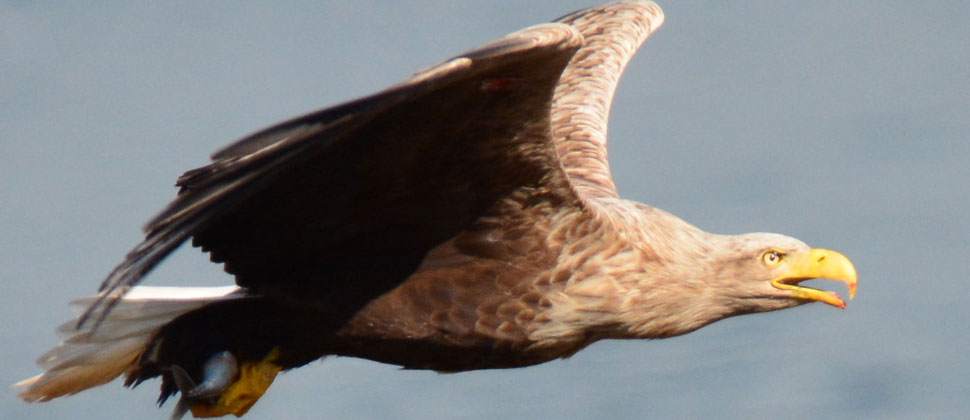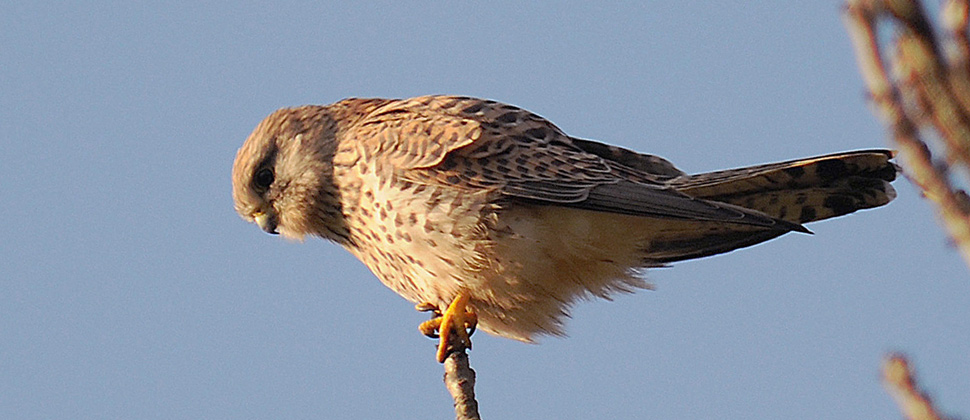News
27 December 2013
Keith Brockie has hit out at the death of golden eagle ‘Fearnan’ who was found poisoned on a grouse moor in the Angus glens earlier this month. Keith, who is a member of Tayside Raptor Study Group, had been closely involved with the tagging and monitoring of this particular eagle, and has spoken out in a newspaper article about the ‘eagle black holes’ on Angus grouse moors (see here). Keith has also published a series of photographs documenting Fearnan’s short life (see here).
23 December 2013
Logan Steele, a Tayside Raptor Study Group member, has called upon the government to introduce estate-licensing and ban driven grouse shooting in the wake of the latest golden eagle poisoning. It is a view shared by many of his colleagues in Raptor Study Groups across the country. Logan’s letter has been published in the Scotsman and can be read here.
19 December 2013
Once again, a young golden eagle has been discovered dead on a grouse moor in the Angus Glens. The victim this time was a two-year-old male called ‘Fearnan‘ – who was being satellite-tracked by SRSG member Roy Dennis. His corpse was found earlier this month in an area with a long history of raptor persecution. He had been poisoned. Further details of this appalling crime can be found here. The Scottish Raptor Study Group will be writing to the Environment Minister, Paul Wheelhouse, to express our deep concern that these crimes continue in 21st Century Scotland. We would encourage everyone to send an email to the Minister to express outrage and disgust and to urge further sanctions against the criminals in the game-shooting industry who are getting away time and time again. The Minister’s email address: ministerforenvironment@scotland.gsi.gov.uk
18 December 2013
Police Scotland are appealing for information after a poisoned buzzard was found dead in Sheriffmuir in September. The police say they are treating the death as an ‘intentional killing’. It is regrettable that it has taken three months for a police appeal to be made. Full story here.
14 December 2013
The third edition of the book Raptors: A Field Guide for Surveys and Monitoring has just been published. The book aims to promote best practice for fieldwork, drawing on the knowledge and experience of over 300 raptor experts, especially the members of the Scottish Raptor Study Group. Incorporating new information and feedback from the 2nd edition, it covers all birds of prey and owls which occur regularly in Britain and Ireland. This is a must-have book for all raptor fieldworkers. The new edition is available in paperback for £18.99 from the TSO shop here. A 33% discount is available to SRSG members, bringing the cost down to £12.67. Contact your Group Chair for the reference code you’ll need to claim your discount.
2 December 2013
RSPB Scotland has today welcomed a decrease in the number of birds reported poisoned in Scotland last year, but has stressed that the illegal killing of birds of prey is still continuing at ‘wholly unacceptable levels’ in some parts of Scotland.
The annual report, entitled The Illegal Killing of Birds of Prey in Scotland in 2012, revealed that some of our rarest species including golden eagles, goshawks, short-eared owls and hen harriers were amongst the victims of human persecution discovered last year. Now in its 19th year of publication, the report provides a consistent recording benchmark on levels of crimes impacting Scotland’s iconic birds of prey.
Whilst the conservation charity has welcomed a decline in confirmed detected poisoning cases compared to previous years, evidence suggests that other forms of illegal killing such as shooting, trapping and nest destruction continue to exact a heavy toll on these vulnerable and protected species.
There were seven confirmed incidents of illegal poisoning, killing or targeting birds of prey in 2012, as well as a further thirteen confirmed incidents of other forms of killing or attempted killing.
In particular, the report highlights three specific cases of crimes against golden eagles – one bird found shot in Dumfries and Galloway; one trapped in Angus; and one poisoned in the Highlands. These deaths were greeted with almost universal public condemnation.
The annual document also draws attention to suspected cases of illegal killing of birds of prey including the destruction of nests or eggs and the disappearance of a number of birds of prey fitted with satellite transmitters, part of scientific research to look at their movements and survival.
As in recent years, the majority of reported incidents or suspected incidents of illegal killing took place in areas managed for driven grouse shooting, particularly in the eastern and central Highlands and the southern Uplands of Scotland.
Stuart Housden, RSPB Scotland Director said “We applaud the continued focus on tackling raptor persecution by the Scottish Government, but much remains to be done. We also welcome the decline in illegal poisoning; however if those who wish harm to our country’s birds of prey simply turn to other forms of persecution, such as shooting or trapping, then there is little to celebrate. The deaths of these golden eagles are particularly appalling, given that the golden eagle was recently voted the nation’s favourite species in the SNH poll for the Year of Natural Scotland. We call for a new look at how the full rigour of the law can be applied in cases of raptor persecution to act as a meaningful deterrent to those considering illegal activity of this type. These crimes have no place in 21st century Scotland, and responsible land managers must make that clear to all partners”.
Ian Thomson, RSPB Scotland’s Head of Investigations added: “Again, most of these crimes were discovered purely by chance, by local residents, walkers or birdwatchers, in remote areas of countryside, so we thank the public for their continued vigilance.
“From the cases outlined in this report, it is clear that a significant number of individuals still flout the laws protecting our native birds of prey. We accept that legal predator control of foxes and crows, alongside appropriate habitat management can have conservation benefits for some ground nesting birds. But we need our moors to be managed sustainably, in ways that are not narrowly focussed on ever-increasing grouse bags, and this includes giving a home to the raptors which should occur on these moors. It is only when species like the hen harrier and golden eagle are breeding successfully and regularly in such areas that we can be confident that bird of prey persecution is truly declining”.
The report is available for download here
1 December 2013
The National Trust for Scotland has produced a fantastic video, featuring footage filmed at a golden eagle’s nest in 2013. The video was made with the assistance of the Scottish Raptor Study Group. Watch the ~6 minute film here.
28 November 2013
A new scientific publication has documented a 20% decline in the Scottish hen harrier population over a six-year period. A national survey was carried out in 2010 and the results indicate an estimated population of 505 territorial pairs. The previous national survey was conducted in 2004 and estimated 633 territorial pairs. The paper’s authors suggest that the decreases may be related to habitat change and illegal persecution.
Hayhow, D.B., Eaton, M.A., Bladwell, S., Etheridge, B., Ewing, S.R., Ruddock, M., Saunders, R., Sharpe, C., Sim, I.M.W. and Stevenson, A. (2013). The status of the Hen Harrier, Circus cyaneus, in the UK and Isle of Man in 2010. Bird Study, Volume 60, Issue 4.
The full paper is available for free download here
25 November 2013
SNH is inviting public opinion on the development of the 2013 Core Areas of Wild Land Map. A draft version of this map, which identifies areas of wild land character which are significant in a national context, has been prepared by SNH to help inform planning policy in these areas. SNH’s definition of wild land includes habitats and wildlife; the Scottish Raptor Study Group will be preparing a consultation response in relation to important areas for raptors and their prey. For further information about the public consultation, including how to take part, please click here.
18 November 2013
It’s hailed as an icon of wild Scotland, used on company logos, place names and ancient burial sites, and recently voted the nation’s favourite animal, now a new campaign is aiming to see the golden eagle named as the country’s national bird.
Fronted by wildlife cameraman Gordon Buchanan, RSPB Scotland has submitted a petition urging ministers to formally designate the species as a national symbol, placing it alongside the lion rampant, saltire and Scottish thistle as emblems of the country.
There are currently just 431 pairs of golden eagles in the whole of Scotland. Owing to centuries of persecution, this most charismatic of birds has been almost entirely confined to the more remote areas of the country, such as the mountains and glens of the west coast and on the western isles, with numbers held at artificially low levels and many territories vacant.
Its restricted range and tendency to favour the more remote and dramatic areas has made it become a coveted sight for any visitor who appreciates Scotland’s magnificent wildlife spectacles.
But now the nature conservation charity is pressing for the adoption of the golden eagle as Scotland’s national bird, helping to raise its profile, turn around its fortunes and see it return once again to its former range thus increasing the chances of a sighting for visitors and local people.
Wildlife cameraman Gordon Buchanan added: “The thrill of seeing a golden eagle soaring over a Scottish hillside is an unbeatable experience. For me they symbolise the wildest parts of Scotland and there is no other contender for Scotland’s national bird. Spending my childhood on Mull meant I grew up with eagles. I’ve been lucky enough to see hundreds since and each one is special. But golden eagles could and should be more common. Scots and visitors to Scotland shouldn’t hope that an eagle sighting is a once-in-a-lifetime experience; they should expect to see them regularly. That is why I’m backing the RSPB’s campaign to make Scotland’s national bird, the golden eagle.”
Stuart Housden, Director of RSPB Scotland, said: “The majestic sight of a golden eagle soaring effortlessly above the treetops, or along a dramatic cliff edge never fails to impress, so much so that this spectacular species was recently named Scotland’s favourite animal following a public vote. It is a stirring symbol of strength and pride, qualities well befitting to a modern Scotland and its people. 2013 is the Year of Natural Scotland – a period where the Scottish Government is celebrating our most impressive natural heritage. What better legacy can we provide for this initiative than to officially designate the eagle as Scotland’s national bird and join together for its future conservation? It would formally recognise the place this species has unofficially occupied in our culture for many centuries, and show our commitment and desire to protect and conserve it, and our wider national heritage, for generations to come.”
To show support or find out more please visit here
Archive:
2015
- February,
- January,
2014
- December,
- November,
- October,
- July,
- June,
- May,
- April,
- March,
- February,
- January,
2013
- December,
- November,
- October,
- September,
- August,
- July,
- June,
- May,
- January,
2012
- December,
- November,
- October,
- September,
- August,
- July,
- June,
- May,
- April,
- March,
- February,
- January,





